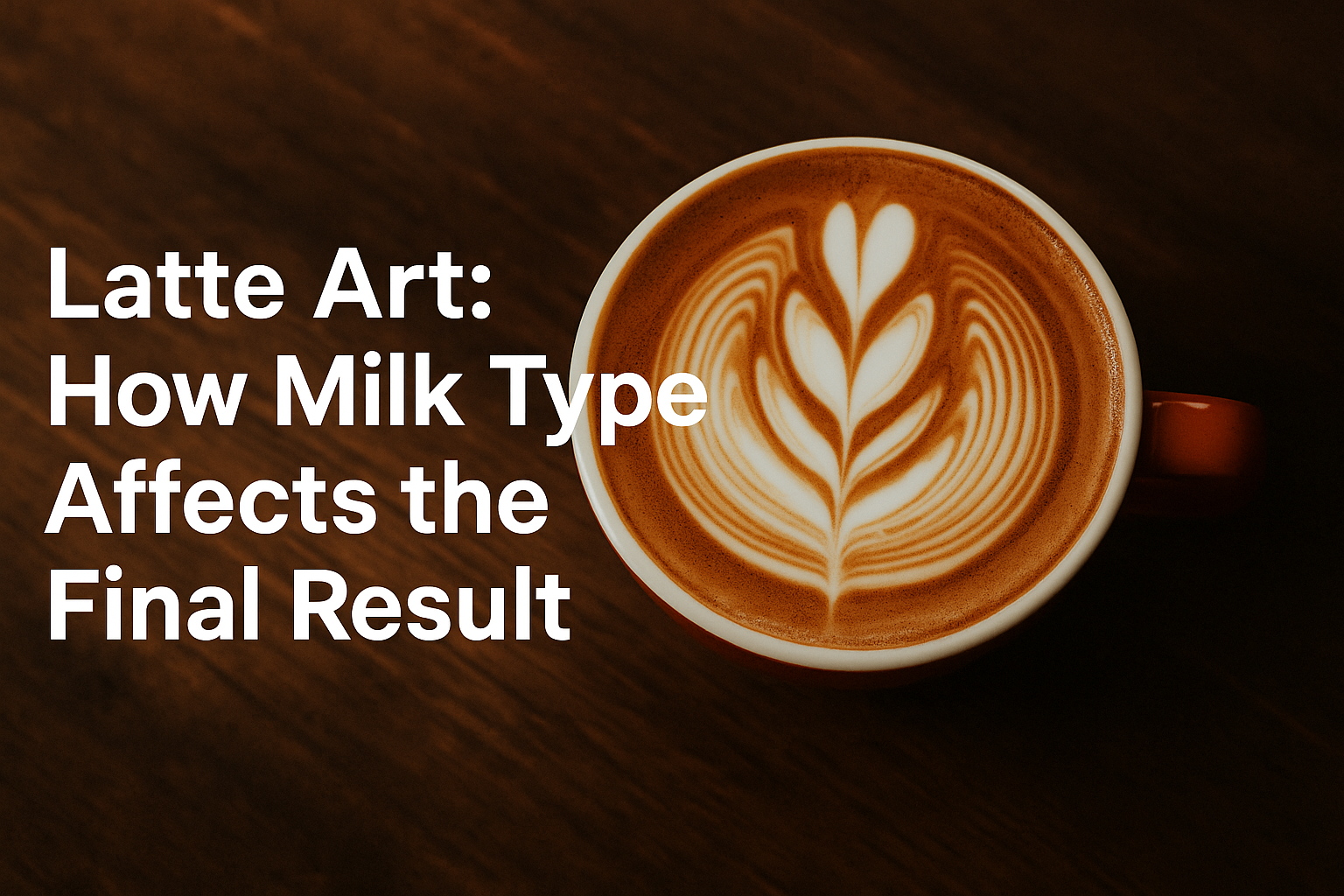In the world of latte art, milk is just as important as espresso. The texture, taste, and look of your final design depend heavily on the type of milk you use.
Whether you’re working with dairy or plant-based alternatives, every choice impacts the way your microfoam behaves and how your design appears.
For baristas and home brewers alike, understanding the science behind milk types can help improve not just the art — but the entire experience of a well-made coffee.
Let’s dive into how different types of milk influence latte art, from stretchability to contrast and taste.
Why Milk Matters in Latte Art
Latte art is created by pouring textured milk into espresso. The steamed milk blends with the crema, forming patterns like hearts, tulips, and rosettas. To achieve clean lines and bold contrast, you need milk that:
- Steams well
- Holds microfoam
- Pours smoothly
- Balances well with espresso
These qualities vary from one milk type to another. Understanding how each option behaves will help you choose the best one for your specific goals.
Whole Milk: The Gold Standard
Whole milk is the go-to for most baristas — and for good reason. It has a balanced fat and protein content that helps create thick, smooth microfoam. The fat contributes to creaminess, while the proteins stabilize the bubbles.
Pros
- Excellent for beginners
- Produces stable and shiny microfoam
- Rich flavor that complements espresso
- Great contrast in designs
Cons
- Higher in calories
- Not suitable for lactose-intolerant or vegan drinkers
If you’re just getting started with latte art, whole milk is your best friend. It’s forgiving and gives predictable results.
2% Milk (Semi-Skimmed)
This is a leaner version of whole milk, with slightly less fat but similar proteins. It can still create decent microfoam, though slightly less rich.
Pros
- Lower in fat
- Still creates decent texture
- Mild flavor
Cons
- Less creamy and stable
- Foam may collapse quicker
Use this if you want to reduce fat but still stick to dairy. You’ll need to pay extra attention to your steaming technique.
Skim Milk (Fat-Free)
Skim milk has very little fat but high protein, which results in a foamier texture that is sometimes too dry. It can create large, stiff bubbles if not steamed carefully.
Pros
- Very light in calories
- Foams quickly
- Can create strong contrast if done well
Cons
- Tends to produce dry, stiff foam
- Less creamy and flavorful
- Harder to control
For skilled baristas, skim milk can work. But for beginners, it’s often frustrating. The designs may look sharp but taste flat.
Lactose-Free Milk
Lactose-free milk is treated with the enzyme lactase, making it digestible for lactose-intolerant people. In texture and performance, it behaves much like regular dairy milk.
Pros
- Same frothing behavior as whole milk
- Great for people with lactose intolerance
Cons
- Slightly sweeter due to broken-down sugars
- Can scorch more easily if overheated
If your customers need lactose-free drinks, this is a safe, effective option. Just monitor your steaming temperature closely.
Oat Milk
Oat milk is one of the most popular plant-based alternatives in cafés today. It has a creamy texture, good protein structure, and neutral flavor that pairs well with espresso.
Pros
- Great stretch and texture
- Neutral taste
- Good contrast in latte art
- Vegan-friendly
Cons
- Can curdle if espresso is too acidic
- Some brands foam better than others
Barista-formulated oat milks work best. They’re optimized for steaming, with added fats and stabilizers that mimic dairy behavior.
Almond Milk
Almond milk is thinner and lower in protein and fat, making it difficult to texture properly. It often produces weak or unstable foam.
Pros
- Light and nutty flavor
- Low in calories
- Widely available
Cons
- Inconsistent results
- Tends to separate or curdle
- Low contrast in latte art
Only specific brands designed for baristas provide decent results. Regular almond milk usually doesn’t hold up well in espresso.
Soy Milk
Soy milk used to be the standard non-dairy option in cafés. It contains more protein than most other alternatives, which helps it foam better than almond or rice milk.
Pros
- Good protein content
- Decent microfoam
- Familiar to many customers
Cons
- Can taste beany or chalky
- May curdle in high-acid espresso
- Less creamy than oat milk
Choose soy milk with added stabilizers for better results. Keep your steaming temperature lower to avoid curdling.
Coconut Milk
Coconut milk offers a rich, tropical flavor and creamy mouthfeel. However, it lacks the protein structure needed for strong microfoam.
Pros
- Distinctive flavor
- Creamy texture
- Vegan-friendly
Cons
- Poor foam stability
- Can be too watery
- Low contrast in designs
Coconut milk is better for flavor than art. It works well in iced lattes but doesn’t deliver reliable results for latte art.
Rice Milk
Rice milk is thin, watery, and low in both fat and protein. It does not foam well and usually doesn’t hold shape in art.
Pros
- Very light and sweet
- Hypoallergenic
Cons
- Practically no foam
- Separates easily
- Poor texture and contrast
Avoid using rice milk for latte art unless necessary for allergy reasons. It’s not a suitable base for professional-looking designs.
Pea Milk
Pea-based milk is a newer alternative with surprising potential. It contains a solid amount of protein and steams more like dairy milk.
Pros
- Good protein for frothing
- Neutral flavor
- Suitable for latte art
Cons
- Limited availability
- Some people dislike the texture
If you’re experimenting with plant-based options, pea milk is worth trying. It has a balanced profile that makes it easier to work with.
Tips for Steaming Non-Dairy Milks
Plant-based milks behave differently than dairy. Here are some tips to improve your results:
- Use barista versions: These are designed for steaming and contain emulsifiers and fats for better texture.
- Keep temperatures lower: Most alternatives scorch or curdle above 55–60°C (131–140°F).
- Start with less air: Overstretching non-dairy milk leads to big, dry bubbles. Stretch quickly, then whirlpool.
- Pour immediately: Plant-based foams separate faster. Don’t wait long after steaming.
You may need to experiment with different brands. Even two cartons of the same type (like oat milk) can behave differently.
Contrast and Color in Latte Art
Milk type affects more than texture — it also influences contrast. High-fat milk like whole milk gives you whiter foam against the brown crema. This creates bolder, cleaner lines.
Plant-based milks often have a grayish tone or foam that blends into the crema, making designs harder to see. Oat and soy usually perform best in this area.
To improve contrast:
- Use fresh espresso with thick crema
- Steam the milk just right — glossy but not dry
- Pour with precision and control
With the right technique, even less-than-ideal milk can produce decent results.
Taste vs. Texture: Finding the Balance
Ultimately, latte art is only part of the experience. The flavor of the milk should complement the coffee. Some milks taste amazing but don’t foam well. Others foam beautifully but taste bland or watery.
Always consider:
- What the customer wants
- The flavor profile of your espresso
- The drink’s temperature and texture
A perfect tulip in a bad-tasting drink doesn’t win hearts. Aim for balance.
Final Thoughts: Choose Milk That Works for You
There’s no single best milk for latte art — only the best milk for your purpose. For beginners, start with whole milk. For non-dairy options, oat milk is the most forgiving. If health or ethics guide your choice, adjust your technique to suit.
The key is to understand how milk behaves, then adapt your skills accordingly. The more you experiment, the more confident you’ll become — and the more impressive your latte art will look and taste.

Marcelo Rodrigues is a passionate barista with over 7 years of experience in specialty coffee. He’s worked in top cafés, led barista training sessions, and now shares practical tips to help beginners and coffee lovers improve their skills. Through this blog, Marcel makes the world of coffee more accessible—one cup at a time.

